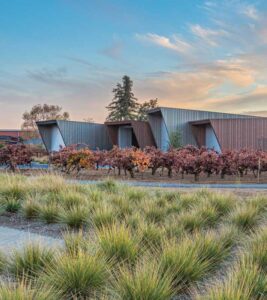
Green buildings play a key role in keeping our planet safe.
In fact, according to the U.S. Department of Energy (DoE), commercial buildings account for 18 quadrillion BTU, 18 percent of the primary energy use in the U.S.1 The Environmental Protection Agency (EPA) estimates that 30 percent of this energy, nearly 5.5 quadrillion BTU, is wasted.2
That is why the commercial architecture industry is taking a leading role in providing a road map to improving climate change through a number of initiatives. From the 2050 Paris Agreement aimed to stabilize greenhouse gas concentrations in the atmosphere at a level that would prevent dangerous anthropogenic interference with the climate system, to the AIA 2030 Commitment—which states all new buildings, developments, and major renovations shall be carbon-neutral by 2030—efforts are well underway to improve commercial construction.
And architects now have more sustainable building materials at their fingertips to specify to achieve sustainability goals and certifications. And insulated metal panels (IMPs) are no exception.
A composite panel assembly of two steel skins with an insulating foam core, IMPs provide water, air, vapor, and thermal control layer continuity. They are composed of an energy-efficient, continuously foamed-in-place polyisocyanurate foam insulation sandwiched between a finished metal exterior and interior face.
Insulated metal wall systems provide an exterior rainscreen and insulation, along with an air and vapor barrier that provides architects with a sustainable solution with control layer continuity—all achieved within one component.
Sustainable credentials
While no single product contributes points or guarantees that a WELL or LEED credit can be earned, IMPs support a sustainable building design potentially contributing to many categories, including rainwater harvesting, asbestos, vapor management, greenhouse gases, and metrics of energy cost.
For instance, some LEED v4.1 categories that IMPs can contribute include heat island reduction, rainwater management, indoor water use reduction, optimized energy performance, and building lifecycle impact reduction.
For buildings looking to achieve LEED v4.1 certification, IMPs help to achieve water use reduction, as insulated metal roof panels integrated into a building’s rainwater harvesting system can contribute to points. Additionally, IMPs can also be reused and contribute to the points for using salvaged, refurbished, or reused materials for 5 percent of project materials.
When it comes to WELL v2, IMPs provide a similar set of features to help projects achieve certification.
Air quality is one of the hallmarks of WELL certification. This feature sets thresholds for volatile organic compounds (VOCs) that can cause indoor air pollution from the leaching of paints, finishes, cleaning equipment, and various other products. This can cause irritation to building occupants and, in some cases, serious illnesses. IMPs are considered a closed assembly, which means VOCs
cannot leak.
According to WELL, receiving access to proper levels of sunlight can host a variety of benefits to the human organism from neurological, hormonal, and visual system aspects. This precondition states that the envelope glazing area is no less than 7 percent of the regularly occupied floor area for each floor level. This feature can easily be achieved with integrated daylighting systems that seamlessly install within the IMP building envelope. These systems offer easy installation through compatible joinery and allow for an unbroken, continuous high performance building envelope.
IMPs support the construction of the healthiest, most energy- and resource-efficient building projects that seek certification by incorporating a range of design and material choices. Even when projects do not seek certification, pursuing the goals of green building will lead to more informed design decisions that are better for people and the planet.
And while achieving sustainable certifications is the goal, cost savings also help. IMPs can deliver a solar reflectance and thermal emittance that creates a “cool wall” that can lead to an annual HVAC cost savings of up to 11 percent,3 according to research from Berkeley Lab. Similarly, IMPs are offered in finishes that have high Solar Reflectance Index (SRI) values, reducing energy costs. Cool roofs and walls on a building can also help significantly save on initial capital by reducing the size of the HVAC systems.
Many panel manufacturers are committed to the planet and making a positive impact on future generations, and IMPs play a big part in that effort. Recognizing the use of LEED certification, some manufacturers have developed a comprehensive guide to assist project teams and professionals in achieving LEED v4 and v4.1 certification. The guide outlines the sustainable features and attributes of their products, facilitating the incorporation of environmentally-friendly materials into construction projects.
In addition, through Planet Passionate—a 10-year global sustainability program—some panel manufacturers are working to be directly powered by 60 percent renewable energy by 2030 and achieve zero waste and increase material efficiency.
Notes
1,2 See energy.gov/eere/buildings/about-commercial-buildings-integration-program
3 See newscenter.lbl.gov/2019/07/09/cool-walls-can-reduce-energy-costs-pollution/
Maggie Sexton is sustainability manager for All Weather Insulated Panels (AWIP). AWIP is an innovator in the design, construction, and advancement of foam composite insulated metal panels (IMPs) and has three continuous line manufacturing facilities across the U.S.


